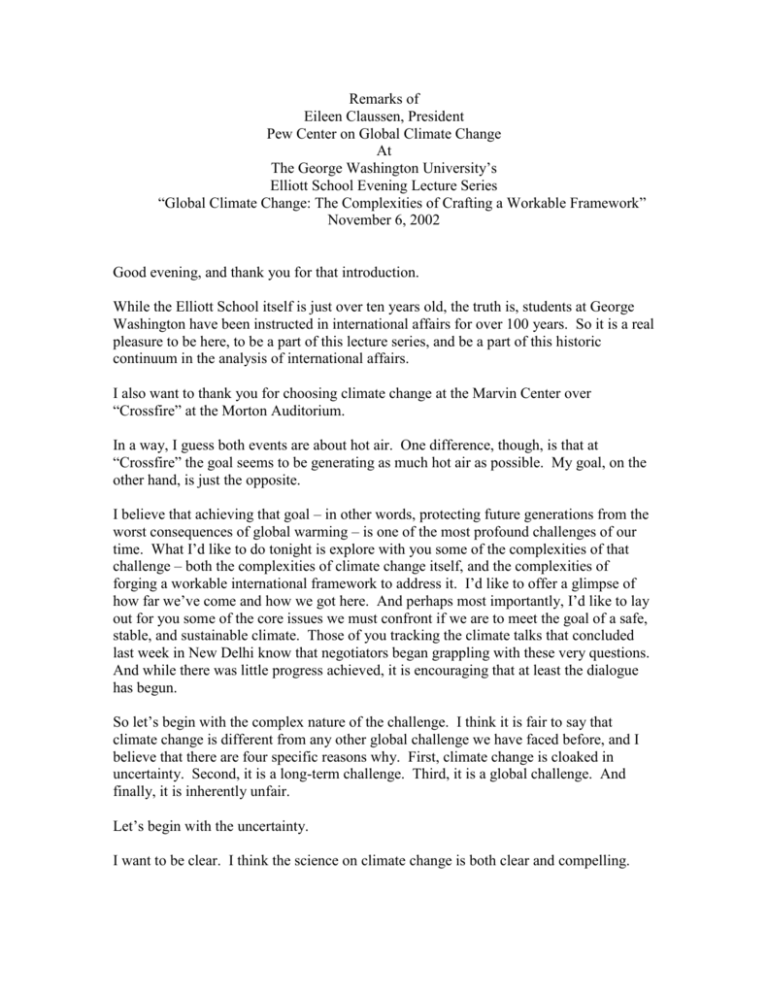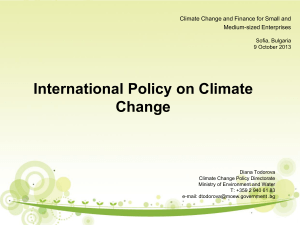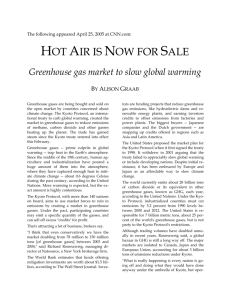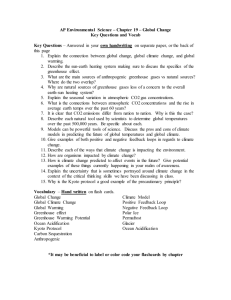Transcript (in Word format)
advertisement

Remarks of Eileen Claussen, President Pew Center on Global Climate Change At The George Washington University’s Elliott School Evening Lecture Series “Global Climate Change: The Complexities of Crafting a Workable Framework” November 6, 2002 Good evening, and thank you for that introduction. While the Elliott School itself is just over ten years old, the truth is, students at George Washington have been instructed in international affairs for over 100 years. So it is a real pleasure to be here, to be a part of this lecture series, and be a part of this historic continuum in the analysis of international affairs. I also want to thank you for choosing climate change at the Marvin Center over “Crossfire” at the Morton Auditorium. In a way, I guess both events are about hot air. One difference, though, is that at “Crossfire” the goal seems to be generating as much hot air as possible. My goal, on the other hand, is just the opposite. I believe that achieving that goal – in other words, protecting future generations from the worst consequences of global warming – is one of the most profound challenges of our time. What I’d like to do tonight is explore with you some of the complexities of that challenge – both the complexities of climate change itself, and the complexities of forging a workable international framework to address it. I’d like to offer a glimpse of how far we’ve come and how we got here. And perhaps most importantly, I’d like to lay out for you some of the core issues we must confront if we are to meet the goal of a safe, stable, and sustainable climate. Those of you tracking the climate talks that concluded last week in New Delhi know that negotiators began grappling with these very questions. And while there was little progress achieved, it is encouraging that at least the dialogue has begun. So let’s begin with the complex nature of the challenge. I think it is fair to say that climate change is different from any other global challenge we have faced before, and I believe that there are four specific reasons why. First, climate change is cloaked in uncertainty. Second, it is a long-term challenge. Third, it is a global challenge. And finally, it is inherently unfair. Let’s begin with the uncertainty. I want to be clear. I think the science on climate change is both clear and compelling. There is overwhelming scientific consensus on three basic points: the earth is warming; this warming trend is likely to worsen; and human activity is largely to blame. Yes, you can find scientists who will argue otherwise. But these are the findings of the Intergovernmental Panel on Climate Change, which draws on the expertise of hundreds of climate scientists around the world. They are also the findings of a special, wellbalanced panel put together by the National Academy of Sciences at the request of President Bush. True, the earth’s temperature has always fluctuated. But ordinarily these shifts occur over the course of centuries or millennia, not decades. The 1990s were the hottest decade of the entire millennium. The last five years were among the seven hottest on record. Scientists project that over the next century, the average global temperature will rise two to ten degrees Fahrenheit. A ten-degree increase would be the largest swing in global temperature since the end of the last ice age 12,000 years ago. But even knowing all of this, we still cannot accurately predict exactly how much the earth's temperature will rise or how quickly. Will it be just be the two degrees over the next century? Or will it be 10 degrees, the high end of the estimate? Similarly, we can not forecast precisely what impacts will be felt where. Is it safe to assume that if the temperature rise is gradual so, too, will be the impacts? Or, as some scientists believe, is there a significant risk of triggering sudden changes in the climate system that will lead to catastrophic consequences? There are large economic uncertainties, as well. How quickly can our engineers perfect climate-friendly technologies? How quickly will companies and consumers adopt them? Might the economic benefits of addressing climate change be greater than we think because we will at the same time be solving other problems, like air pollution and our costly reliance on imported oil? And how much will this transformation of our economy to climate-friendly technologies actually cost? We don't have good answers to these questions, and because we don’t, some prefer a “wait and see” approach. They argue that the warming might not be as bad as predicted, so why act now?. The problem with that line of thinking is that uncertainty cuts two ways. Maybe the warming will be much worse than the scientists say. And that is a risk I don’t think we can afford to take. The strategies needed to address climate change must be implemented over many years, even decades, and the sooner we begin the less costly they will be. And that brings me to second attribute that makes climate change unique. It is a longterm challenge. The buildup of greenhouse gases in the atmosphere over the past century happened in a blink of the eye on the geological time scale. But measured on the scale of a human lifetime, climate change is very slow moving. The added carbon dioxide now burdening our atmosphere has accumulated over the course of generations. We are beginning to feel and see some of the impacts now. In Alaska, for instance, roads are literally crumbling and homes are sagging as the permafrost begins to melt. And, less dramatic, spring is arriving earlier here and in Europe. But the significant sea level rise… the increased flooding and increased drought… the more powerful storms and extended heat waves… and other types of extreme weather-related events -- those are still decades down the road. Indeed, the full impact of today's emissions will not be felt until the next century. Just as global warming is slow in coming, doing something about it is also a long-term proposition. Certainly, there are steps we can and should take right now - for instance, there are countless ways we could be using energy more efficiently and therby reducing greenhouse gas emissions. But ultimately what is needed is a fundamental transformation in the way we power our homes, our factories, our cars - in short, in the way we power our entire economy. Clearly, this can't happen overnight. It will take time – which, as I alluded to a moment ago, is all the more reason to get started now. Admittedly, making the crucial investments now is a difficult proposition. How many candidates did you hear in the days leading up to yesterday’s election talking specifically about climate change? Sure, a few talked about the environment in general… or related issues like decreasing our reliance on imported oil. But the fact is, our decision-making structures are not geared to taking the long-term view… and neither are most politicians. The same holds true for businesses. Just as our political decisions are made with an eye toward the next election, our investment decisions are made with an eye to the quarterly earnings reports. Part of confronting climate change, then, is learning to think, and to act, for the long term. Climate change is a long term challenge; it is also a global one. And that is the third attribute that really sets this issue apart. The threat to the Earth's ozone layer was certainly a global one, but I don’t know if we have ever before faced a challenge as all-encompassing as global climate change. That’s because the buildup of greenhouse gases in our atmosphere influences the physical and chemical systems that shape climate literally everywhere on Earth. Yes, the impacts of global warming will vary widely from place to place. Floods in one part of the world might be droughts in another. But the fact is, whether the source of the carbon dioxide added to the atmosphere is gridlock on the Beltway or on a street in Beijing, it presents the very same risk. No nation is immune. And thus, by the same token, every nation bears some responsibility for meeting this challenge. For that reason, while it may be noble for any one nation to limit its greenhouse gas emissions, it is an exercise in futility unless, ultimately, we all do. That is not to say that every nation must act at the same time or in the same way. And that brings me to the fourth and final reason why I believe climate changes poses a challenge like none other. Climate change represents a common threat, and a common challenge. But we must also realize that climate change confronts us with extraordinary inequities. Put plainly, climate change is unfair. Consider who is responsible for the emissions. If you look only to the past, the answer seems clear: the industrialized countries. Nearly two-thirds of the greenhouse gases added to the atmosphere over the past century as a result of human activity came from developed countries. Nearly a third was contributed by the United States alone. But looking forward, the equation changes. As developing countries build their economies, they increase their emissions, too… particularly if they use the technologies now in widespread use in the developed world. And before long, probably in a few decades, their emissions will surpass those of the industrialized world. Thus, in the long run, climate change cannot be effectively addressed without also limiting the emissions of the developing countries. And that poses a tough dilemma: developing countries are understandably reluctant to sacrifice their aspirations for the future, to solve a problem that is not of their making. The equity issue, however, is not just one of economics or emissions… but effects also. In other words, when it comes to climate change, there is an unequal distribution of its impacts. Simply by virtue of their location on the planet and their natural endowments, different nations will be affected very differently. And it appears the worst impacts will fall disproportionately on the poorer nations. In Bangladesh, the flooding of low-lying lands could displace millions. In Africa, increased drought and desertification could mean widespread famine. At the end of the day, the consequences of climate change will fall most heavily on the countries that bear least responsibility for it, and are least able to cope with it. I think the world community understood that when we met ten years ago in Rio. It was agreed that for all these reasons, the developed countries would act first. That is why the Kyoto Protocol sets emissions limits only for developed countries. But in time, all countries must be willing to bear their fair share of the responsibility. So where are we today? After a decade of negotiations, we find ourselves on the verge of establishing the first international constraints on greenhouse gas emissions. The European Union and Japan have ratified the Kyoto Protocol and if, as expected, Russia follows suit, the treaty will enter into force within the next 12-18 months. Kyoto forges both a vision, and a formula, for transcending national interests for the sake of a common, global, long-term good. It sets clear goals. And rather than fight the market, it tries to tap the market, and motivate the market, so those goals can be reached as affordably as possible. Thus, with or without the United States, Kyoto is a profound accomplishment and a crucial first step. Of course, now we know, Kyoto will proceed without the United States, the largest emitter. President Bush has rejected Kyoto and offered up instead a domestic strategy that relies exclusively on voluntary action. The President's strategy sets a goal of reducing greenhouse gas intensity 18 percent by 2012. That might sound good, but in reality, it allows actual emissions to keep on growing. It is essentially business as usual and unquestionably inadequate. Still, I think it is also important to realize two things about where we are and how we got here. First, there had evolved a fundamental disconnect in U.S. climate policy. Internationally, George Bush, Sr. begrudgingly attended the Rio Earth Summit in 1992 and signed the UN Framework Convention on Climate Change. The Clinton administration then supported a binding treaty and, in Kyoto, negotiated an ambitious target for reducing U.S. emissions. In fact, the United States was responsible for many, if not most, of the pro-market mechanisms that were negotiated into Kyoto – the emissions trading system is just one example. But at home, the Senate – most notably with the “Byrd-Hagel Resolution”-- had laid down terms that made Kyoto's ratification a remote possibility at best, even with the promarket mechanisms. In addition, the administration was barely contemplating let alone promoting the kinds of measures needed to meet the Kyoto target. In other words, the United States has been both a driver and a drag on the process because it was in no way prepared to deliver at home what it had promised abroad. Of course, George W. Bush could have worked with other countries to address U.S. concerns within the Kyoto framework. But that’s not the option he and his administration chose. Regardless, there is a second thing we must realize about the current situation. And that is that despite President Bush’s rejection of Kyoto, we are making progress – more than many people realize. That’s because President Bush’s stance may have saved the Protocol abroad as other nations rallied behind it… and elevated the issue at home. Climate change has become a political story in the United States, and in Congress, members of both parties are more eager to demonstrate their interest in climate protection. As a matter of fact, nearly twice as many climate change bills were introduced in Congress over the past year as in the previous four years combined. I mentioned that Kyoto was moving forward with or without the United States. Well, in the United States, concrete steps are being taken to meet the challenge of climate change… with or without Washington. At the state and local level governments aren’t just debating. They’re acting… and producing results. States and communities are delivering real emission reductions, along with other benefits, like cleaner air and lower tax bills. Many companies are not waiting for federal government mandates either -- they're taking steps to reduce their emissions right now. At last count, we had identified more than 40 major companies that have publicly committed themselves to greenhouse gas reduction targets. But it’s not enough. These voluntary efforts are important, and they are to be commended. But the companies that are truly committed to tackling climate change know that we will never achieve the deep emission cuts we need unless everyone moves far enough, and fast enough, in the right direction. And that will happen only if the government requires it. The same holds true on the international level. Even if our current domestic efforts advance to the stage where they parallel those defined by Kyoto… and even if these two structures for reducing emissions ultimately converge…. they are still just initial steps in a much longer journey to stabilize greenhouse gas concentrations at levels that are safe. A decade ago in Rio, it was acknowledged that to truly address climate change, we needed the “widest possible cooperation by all countries." Ten years later, that is still exactly where we need to go. We must continue to work towards an international framework – one that includes the sustained participation of the world’s largest emitters, developed and developing countries alike. That means reengaging the United States. It means building on Kyoto. Ultimately, it means looking beyond Kyoto. People have worked so hard over the last ten years to bring Kyoto to life that the understandable tendency is to look at Kyoto as the end in itself But to paraphrase Winston Churchill, Kyoto is not the end. It is not even the beginning of the end. But rather, Kyoto is just the end of the beginning. That is not a criticism, by any means. Kyoto is a critical tool that has brought us to a critical stage. Kyoto requires that negotiations toward a second round of targets start by 2005. That may present the first formal opportunity to begin shaping a post-Kyoto regime. But if we are to seize that opportunity, we must start thinking openly and critically right now about the best way forward. So how do we move beyond Kyoto? How do we create a workable international framework? One place to start is by recalling the fundamental characteristics that make the climate change challenge so unique. I talked earlier about climate change being a long-term challenge. Perhaps a new framework requires a specific long-term goal. After all, the only way to meet the objective set in Rio - stabilizing greenhouse gas concentrations at levels that are safe - is to reduce emissions. So wouldn't it make sense to define this objective more concretely in other words, to set a specific concentration target - so we know just how much emissions must be cut? The answer to that question is an unequivocal… maybe. There is no question that a quantified target would help determine the scale and timing of global emissions reductions. But there is also no question that negotiating such a target would prove to be extraordinarily difficult. What are the benefits and what are the obstacles? Are there alternative approaches? Perhaps we should aim for consensus on the overall direction and pace of our effort and ensure that near and medium-term efforts are adequately oriented to the long-term goal of climate stabilization. A second critical issue is cost. Simply put, the viability and, ultimately, the success of any climate strategy rests in part on its ability to ensure that greenhouse gas reductions are achieved at the least possible cost. That is why as we look beyond Kyoto, it is even more critical that we achieve the maximum environmental gain for dollar invested. Better market mechanisms may be part of the answer. But we must also ask if we can minimize cost by aiming for steeper reductions later rather than sooner? And if so, as I suspect, how do we send a strong, early signal to the marketplace so companies begin investing now in the technologies that will be needed to deliver deep reductions decades down the road? Crafting a workable framework will also require us to rethink the structure of commitments. Whereas the Kyoto Protocol employs absolute targets requiring fixed-percentage reductions… a post-Kyoto regime with broader participation will likely have to accommodate widely varying circumstances among nation. Should these targets be pegged to carbon intensity or GDP; should there be “growth” targets that allow developing countries to raise emissions? Could there be commitments that evolve from voluntary to mandatory? Finally, to be effective, a long-term climate regime must be fair. Politically, the most difficult challenge in elaborating an effective post-Kyoto regime will be determining an equitable sharing of responsibility among nations both not just for reducing emissions… but for addressing the impacts of climate change. Notions of fairness are not only elusive but shift over time. For instance, as I said earlier, there was consensus in Rio that developed countries should act first. Yet some, particularly here in the United States, did not agree. Indeed, in rejecting Kyoto, President Bush declared it unfair to the United States because it did not mandate action by developing countries like China and India. Interestingly, though, the Administration made a very different case at the recent talks in Delhi. There it argued that it would be unfair to ask commitments of developing countries because they must focus on reducing poverty and growing their economies. Delivering one message at home and another abroad is perhaps a way to impede progress on both fronts. It also underscores the potency of the equity argument and some of the difficulties we face in resolving it. But resolve it we must. Because in the end, nations will not commit to a serious, long-term global plan against climate change, let alone abide by it, unless each perceives it to be fair. A long-term target. Cost-effectiveness. The structure of our commitments. And fairness. These are all tough issues, and right now, at least, they tend to lead to as many questions as they do answers. But these are the core issues in shaping a post-Kyoto regime. These are the issues we will have to analyze and understand if we are to meet the complicated challenge of global climate change. I think that is a challenge we will meet. Not by yelling about it on “Crossfire”… but by committing to the challenge over the next decades… By building on Kyoto and moving beyond it… By having the ingenuity, savvy and fortitude needed to develop the technologies here at home… and participate in the treaties abroad. And by crafting an international framework. One that is all-inclusive… one that is lasting…and one that works for everyone. .






